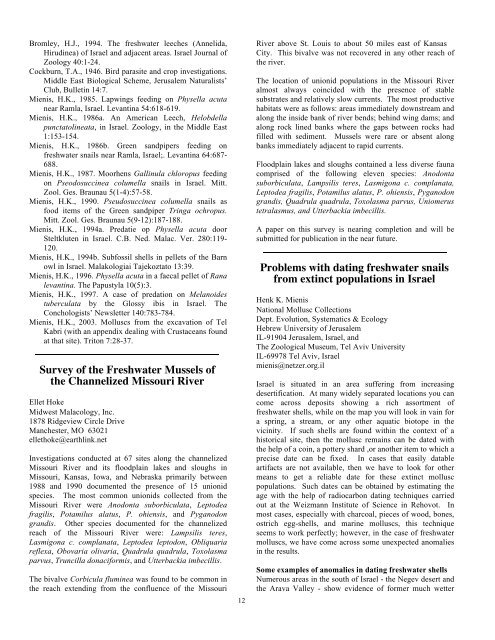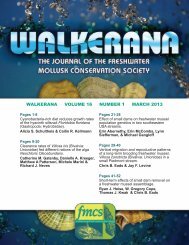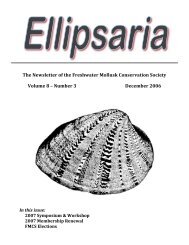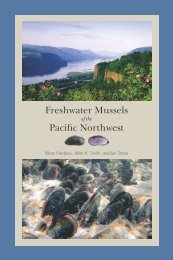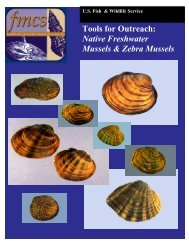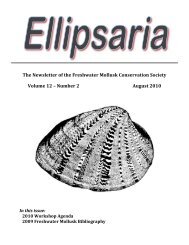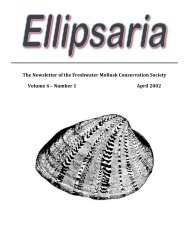August 2004 - FMCS-Freshwater Mollusk Conservation
August 2004 - FMCS-Freshwater Mollusk Conservation
August 2004 - FMCS-Freshwater Mollusk Conservation
You also want an ePaper? Increase the reach of your titles
YUMPU automatically turns print PDFs into web optimized ePapers that Google loves.
Bromley, H.J., 1994. The freshwater leeches (Annelida,<br />
Hirudinea) of Israel and adjacent areas. Israel Journal of<br />
Zoology 40:1-24.<br />
Cockburn, T.A., 1946. Bird parasite and crop investigations.<br />
Middle East Biological Scheme, Jerusalem Naturalists’<br />
Club, Bulletin 14:7.<br />
Mienis, H.K., 1985. Lapwings feeding on Physella acuta<br />
near Ramla, Israel. Levantina 54:618-619.<br />
Mienis, H.K., 1986a. An American Leech, Helobdella<br />
punctatolineata, in Israel. Zoology, in the Middle East<br />
1:153-154.<br />
Mienis, H.K., 1986b. Green sandpipers feeding on<br />
freshwater snails near Ramla, Israel;. Levantina 64:687-<br />
688.<br />
Mienis, H.K., 1987. Moorhens Gallinula chloropus feeding<br />
on Pseodosuccinea columella snails in Israel. Mitt.<br />
Zool. Ges. Braunau 5(1-4):57-58.<br />
Mienis, H.K., 1990. Pseudosuccinea columella snails as<br />
food items of the Green sandpiper Tringa ochropus.<br />
Mitt. Zool. Ges. Braunau 5(9-12):187-188.<br />
Mienis, H.K., 1994a. Predatie op Physella acuta door<br />
Steltkluten in Israel. C.B. Ned. Malac. Ver. 280:119-<br />
120.<br />
Mienis, H.K., 1994b. Subfossil shells in pellets of the Barn<br />
owl in Israel. Malakologiai Tajekoztato 13:39.<br />
Mienis, H.K., 1996. Physella acuta in a faecal pellet of Rana<br />
levantina. The Papustyla 10(5):3.<br />
Mienis, H.K., 1997. A case of predation on Melanoides<br />
tuberculata by the Glossy ibis in Israel. The<br />
Conchologists’ Newsletter 140:783-784.<br />
Mienis, H.K., 2003. Molluscs from the excavation of Tel<br />
Kabri (with an appendix dealing with Crustaceans found<br />
at that site). Triton 7:28-37.<br />
Survey of the <strong>Freshwater</strong> Mussels of<br />
the Channelized Missouri River<br />
Ellet Hoke<br />
Midwest Malacology, Inc.<br />
1878 Ridgeview Circle Drive<br />
Manchester, MO 63021<br />
ellethoke@earthlink.net<br />
Investigations conducted at 67 sites along the channelized<br />
Missouri River and its floodplain lakes and sloughs in<br />
Missouri, Kansas, Iowa, and Nebraska primarily between<br />
1988 and 1990 documented the presence of 15 unionid<br />
species. The most common unionids collected from the<br />
Missouri River were Anodonta suborbiculata, Leptodea<br />
fragilis, Potamilus alatus, P. ohiensis, and Pyganodon<br />
grandis. Other species documented for the channelized<br />
reach of the Missouri River were: Lampsilis teres,<br />
Lasmigona c. complanata, Leptodea leptodon, Obliquaria<br />
reflexa, Obovaria olivaria, Quadrula quadrula, Toxolasma<br />
parvus, Truncilla donaciformis, and Utterbackia imbecillis.<br />
The bivalve Corbicula fluminea was found to be common in<br />
the reach extending from the confluence of the Missouri<br />
12<br />
River above St. Louis to about 50 miles east of Kansas<br />
City. This bivalve was not recovered in any other reach of<br />
the river.<br />
The location of unionid populations in the Missouri River<br />
almost always coincided with the presence of stable<br />
substrates and relatively slow currents. The most productive<br />
habitats were as follows: areas immediately downstream and<br />
along the inside bank of river bends; behind wing dams; and<br />
along rock lined banks where the gaps between rocks had<br />
filled with sediment. Mussels were rare or absent along<br />
banks immediately adjacent to rapid currents.<br />
Floodplain lakes and sloughs contained a less diverse fauna<br />
comprised of the following eleven species: Anodonta<br />
suborbiculata, Lampsilis teres, Lasmigona c. complanata,<br />
Leptodea fragilis, Potamilus alatus, P. ohiensis, Pyganodon<br />
grandis, Quadrula quadrula, Toxolasma parvus, Uniomerus<br />
tetralasmus, and Utterbackia imbecillis.<br />
A paper on this survey is nearing completion and will be<br />
submitted for publication in the near future.<br />
Problems with dating freshwater snails<br />
from extinct populations in Israel<br />
Henk K. Mienis<br />
National Mollusc Collections<br />
Dept. Evolution, Systematics & Ecology<br />
Hebrew University of Jerusalem<br />
IL-91904 Jerusalem, Israel, and<br />
The Zoological Museum, Tel Aviv University<br />
IL-69978 Tel Aviv, Israel<br />
mienis@netzer.org.il<br />
Israel is situated in an area suffering from increasing<br />
desertification. At many widely separated locations you can<br />
come across deposits showing a rich assortment of<br />
freshwater shells, while on the map you will look in vain for<br />
a spring, a stream, or any other aquatic biotope in the<br />
vicinity. If such shells are found within the context of a<br />
historical site, then the mollusc remains can be dated with<br />
the help of a coin, a pottery shard ,or another item to which a<br />
precise date can be fixed. In cases that easily datable<br />
artifacts are not available, then we have to look for other<br />
means to get a reliable date for these extinct mollusc<br />
populations. Such dates can be obtained by estimating the<br />
age with the help of radiocarbon dating techniques carried<br />
out at the Weizmann Institute of Science in Rehovot. In<br />
most cases, especially with charcoal, pieces of wood, bones,<br />
ostrich egg-shells, and marine molluscs, this technique<br />
seems to work perfectly; however, in the case of freshwater<br />
molluscs, we have come across some unexpected anomalies<br />
in the results.<br />
Some examples of anomalies in dating freshwater shells<br />
Numerous areas in the south of Israel - the Negev desert and<br />
the Arava Valley - show evidence of former much wetter


